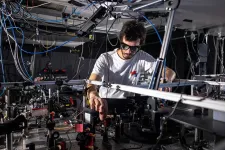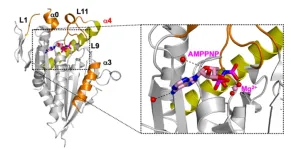(Press-News.org) The research, published today in Nature Geoscience and led by the University of Bristol and National Oceanic and Atmospheric Administration (NOAA), puts the rise in part down to the chemicals, known as chlorofluorocarbons or CFCs, being used to make other ozone-friendly alternatives to CFCs. This is an exception allowed under the Montreal Protocol, but contrary to its wider goals.
Lead author Dr Luke Western, a Research Fellow at the University of Bristol and researcher at the NOAA’s Global Monitoring Laboratory (GML), said: “We’re paying attention to these emissions now because of the success of the Montreal Protocol. CFC emissions from more widespread uses that are now banned have dropped to such low levels that emissions of CFCs from previously minor sources are more on our radar and under scrutiny.”
According to the researchers, emissions from these CFCs currently do not significantly threaten ozone recovery. But because they’re potent greenhouse gases, they still affect the climate.
“Combined, their emissions are equal to the CO2 emissions in 2020 for a smaller developed country like Switzerland, said Western. That’s equivalent to about one percent of the total greenhouse gas emissions in the United States,” added Dr Western.
The international study was conducted by a team of scientists from the UK, US, Switzerland, Australia, and Germany.
CFCs are chemicals known to destroy Earth’s protective ozone layer. Once widely used in the manufacture of hundreds of products including aerosol sprays, such as blowing agents for foams and packing materials, solvents, and in refrigeration, CFC production for such uses was banned under the Montreal Protocol in 2010.
However, the international treaty didn’t eliminate the creation of CFCs during production of other chemicals including hydrofluorocarbons or HFCs, which were developed as second-generation replacements for CFCs.
This study focused on five CFCs with few, or no, known current uses—CFC-13, CFC-112a, CFC-113a, CFC-114a, and CFC-115—and that have atmospheric lifetimes ranging from 52-640 years. In terms of their impact on the ozone layer, these emissions were equivalent to around one quarter of a recently detected rise in emissions of CFC-11, a substance controlled under the Montreal Protocol, thought to be due to unreported new production.
In this study, the team used measurements from the Advanced Global Atmospheric Gases Experiment (AGAGE), in which the University of Bristol plays a pivotal role, as well as others made by Forschungszentrum Jülich, in Germany, the University of East Anglia, and NOAA in the US. These were combined with an atmospheric transport model to show that global atmospheric abundances and emissions of these CFCs increased after their production for most uses was phased out in 2010.
The researchers determined that for three CFCs they studied – CFC-113a, CFC-114a and CFC-115 – the increased emissions may be partly due to their use in the production of two common HFCs used primarily in refrigeration and air conditioning. The drivers behind increasing emissions of the other two CFCs, CFC-13 and CFC-112a, are less certain.
Although the team found rising global emissions, they weren’t able to identify particular locations.
“Given the continued rise of these chemicals in the atmosphere, perhaps it is time to think about sharpening the Montreal Protocol a bit more,” said study co-author Dr Johannes Laube, from the Institute of Energy and Climate Research (IEK) at Forschungszentrum Jülich.
According to the researchers, if emissions of these five CFCs continue to rise, their impact may negate some of the benefits gained under the Montreal Protocol. The study noted these emissions might be reduced or avoided by reducing leakages associated with HFC production and by properly destroying any co-produced CFCs.
Dr Western concluded: “The key takeaway is that the production process for some of the CFC-replacement chemicals may not be entirely ozone-friendly, even if the replacement chemicals themselves are.”
END
Research finds global emissions of several banned ozone-destroying chemicals are increasing
2023-04-03
ELSE PRESS RELEASES FROM THIS DATE:
Early menopause, later start to hormone therapy may increase risk of Alzheimer’s disease
2023-04-03
BOSTON — Women are more likely than men to develop Alzheimer’s disease (AD), with women making up two-thirds of the population living with AD. A new study, led by Mass General Brigham researchers, sheds light on the relationship between the risk of Alzheimer’s disease and age of menopause and use of hormone therapy (HT). The results, published in JAMA Neurology, indicate that early age at menopause may be a risk factor for AD dementia, but that women who were prescribed HT around the age of menopause onset did not show increased risk.
“HT is the most reliable way to ameliorate severe menopause symptoms, ...
Comparison of postpartum opioid prescriptions before vs during pandemic
2023-04-03
About The Study: In this study of 460,000 privately insured postpartum women, patients who gave birth to a single, live newborn after March 2020 were more likely to fill more potent and more frequent opioid prescriptions than patients who gave birth prior to March 2020. Increases were larger for patients delivering via cesarean birth than those delivering vaginally. Increases in opioid prescriptions may be associated with increased risk of opioid misuse, opioid use disorder, and opioid-related overdose among postpartum women.
Authors: Shelby R. Steuart, M.P.A., of ...
Genetics of preterm birth and pregnancy length clarified
2023-04-03
New knowledge of the genetic factors behind premature delivery and gestational duration has now emerged. Findings presented by a major international study under the aegis of the University of Gothenburg include the ways in which, before birth, the woman’s and the unborn child’s genes have mutually antagonistic effects.
These results, now published in the journal Nature Genetics, enhance the potential for long-term development of drugs to induce parturition (birth) and — even more importantly — achieve the goal of preventing preterm births.
Globally, preterm (or premature) birth is the most frequent immediate cause of death among newborns and children ...
More U.S. prostate cancer patients choosing active surveillance
2023-04-03
The number of prostate cancer patients in the U.S. choosing active surveillance over surgery or radiation has rapidly increased since 2010, rising from 16% to 60% for low-risk patients and from 8% to 22% for patients with favorable intermediate-risk cancers, according to a study published today in JAMA Internal Medicine.
Active surveillance includes actively monitoring prostate cancer for progression, with the intention to intervene with surgery or radiation therapy if the cancer progresses.
It is the preferred treatment option for men with low-risk ...
Double-slit experiment that proved the wave nature of light explored in time
2023-04-03
Imperial physicists have recreated the famous double-slit experiment, which showed light behaving as particles and a wave, in time rather than space.
The experiment relies on materials that can change their optical properties in fractions of a second, which could be used in new technologies or to explore fundamental questions in physics.
The original double-slit experiment, performed in 1801 by Thomas Young at the Royal Institution, showed that light acts as a wave. Further experiments, however, showed that light actually ...
Researchers show lorlatinib is safe and effective for patients with ALK-driven relapsed/refractory high-risk neuroblastoma
2023-04-03
Philadelphia, April 3, 2023—In a significant step for the treatment of neuroblastoma, an international group of researchers led by Children’s Hospital of Philadelphia (CHOP), Winship Cancer Institute of Emory University and the New Approaches to Neuroblastoma Therapy (NANT) Consortium has shown that the targeted therapy lorlatinib is safe and effective in treating high-risk neuroblastoma. The findings, published today in Nature Medicine, have led to a major amendment in a phase 3 Children’s Oncology Group (COG) clinical trial, which has incorporated lorlatinib for newly diagnosed ALK-driven high-risk neuroblastoma, ...
Hidden ice melt in Himalaya: Study
2023-04-03
A new study reveals that the mass loss of lake-terminating glaciers in the greater Himalaya has been significantly underestimated, due to the inability of satellites to see glacier changes occurring underwater, with critical implications for the region's future projections of glacier disappearance and water resources.
Published in Nature Geoscience on April 3, the study was conducted by an international team including researchers from the Chinese Academy of Sciences (CAS), Graz University of Technology (Austria), the University of St. Andrews (UK), and Carnegie Mellon ...
Hannover Messe: Smart films help to make loudspeakers lighter and more energy-efficient
2023-04-03
Professors Stefan Seelecke and Paul Motzki at Saarland University are developing intelligent materials that are opening up new avenues in sound reproduction technology: lightweight loudspeakers that use far less energy than their conventional counterparts, novel shapes for sound and signal generators and applications involving noise cancelling textiles. The basis for these smart materials are ultrathin silicone films that can act as artificial muscles with their own built-in sensors. The research team will be showcasing their new technology at this year’s Hannover Messe from 17 to 21 April (Hall 2, Stand B34).
Ultrathin films may well replace the heavy and power-thirsty ...
LSU Health New Orleans LA Tumor Registry releases 6th Census Tract Cancer Incidence Report
2023-04-03
New Orleans, LA -- LSU Health New Orleans Louisiana Tumor Registry (LTR) has published the sixth report of statewide cancer incidence rates by census tract. The publication, which reports 2010-2019 combined cancer incidence data, found that 81% of the census tracts in Louisiana met publication criteria for all cancers combined. For specific cancer types, fewer census tracts met the criteria. For the Louisiana census tracts meeting the criteria, the incidence rates for all cancers combined and for specific cancer types were compared with the corresponding rates for the entire state. The ...
Anticancer drugs with fewer side-effects: scientists decode the crystal structure of a key cell cycle protein
2023-04-03
Anticancer drugs are pivotal to cancer treatment, but their toxicity may not always be limited to cancer cells, resulting in harmful side-effects. To develop anticancer therapies that have fewer adverse effects on patients, scientists are now focusing on molecules that are less toxic to cells. One such group of drugs is the "kinesin inhibitors." These inhibitors prevent cancer progression by explicitly targeting kinesin motor proteins, which are required for the division of cancer cells. Centromere-associated protein E (CENP-E), a member of the kinesin motor protein, is a promising target for inhibitor therapy, as it is essential for tumor cell replication. However, determining the ...







